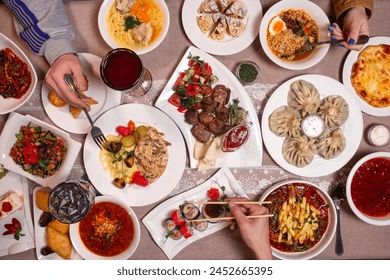Food is more than sustenance—it’s a passport to the world. Imagine standing in a vibrant festival, the air thick with the aroma of sizzling street tacos, fragrant curry, and freshly baked baklava. Each bite tells a story of culture, history, and tradition. Cultural food festivals are a celebration of global diversity, bringing people together to taste, learn, and connect. In this article, we’ll dive into the magic of one such festival, exploring why these events are a must-visit, what you can expect, and how to make the most of your experience. Whether you’re a foodie, a traveler, or someone curious about the world, this festival will leave you hungry for more.
What Is a Cultural Food Festival?
A cultural food festival is a vibrant gathering that showcases cuisines from around the globe, often tied to specific cultural or ethnic traditions. These events blend food, music, dance, and storytelling to create an immersive experience. Think of it as a culinary world tour without leaving your city.
Why These Festivals Matter
They’re not just about eating—they’re about connection. Food festivals bridge gaps between communities, offering a taste of cultures you might not encounter daily. From learning the history behind a dish to meeting the people who make it, these events foster understanding and appreciation.
The Festival: A Global Feast in One Place
Let’s focus on the World Food Festival, an annual event held in cities like San Francisco, London, and Melbourne, known for its diverse culinary offerings. Picture a sprawling outdoor market with colorful stalls, each representing a different country. From Ethiopian injera to Japanese takoyaki, the festival is a sensory overload in the best way possible.
A Snapshot of the World Food Festival
Held over a weekend in August 2025, the San Francisco World Food Festival transforms the Embarcadero into a global village. With over 100 vendors, live cooking demos, and cultural performances, it draws thousands of visitors. It’s a place where you can savor Peruvian ceviche one moment and Nigerian jollof rice the next.
Why You Should Attend
Attending a cultural food festival isn’t just about filling your stomach—it’s about feeding your soul. These events offer a unique opportunity to explore global cuisines, learn about traditions, and connect with people from different backgrounds. Plus, they’re just plain fun.
A Taste of Adventure
Ever wanted to try Moroccan tagine but didn’t know where to start? At the festival, you can sample small portions, ask vendors about their recipes, and discover new favorites. It’s like a low-stakes culinary adventure—no passport required.
Cultural Immersion Without the Plane Ticket
You don’t need to fly to Thailand to taste authentic pad Thai. The festival brings the world to you, with vendors often hailing from the cultures they represent. You’ll hear stories of family recipes passed down through generations, making each dish feel personal.
Community and Connection
There’s something magical about sharing food with strangers. At the festival, you’ll strike up conversations with fellow food lovers, swap recommendations, and maybe even make a new friend over a shared love of dumplings.
What to Expect at the World Food Festival
Walking into the World Food Festival feels like stepping into a global marketplace. The air buzzes with music, laughter, and the clatter of cooking. Here’s a breakdown of what you’ll find:
Food Stalls Galore
- Diversity: Over 100 stalls representing cuisines from Asia, Africa, Europe, Latin America, and beyond.
- Portion Sizes: Most vendors offer small, affordable portions, perfect for sampling multiple dishes.
- Authenticity: Many vendors are first- or second-generation immigrants, bringing family recipes to life.
Live Cooking Demonstrations
Chefs from around the world take the stage to show you how to make everything from Indian naan to Mexican mole. These demos are interactive, so you might even get to knead dough or stir a pot.
Cultural Performances
Expect traditional dances, music, and storytelling. Last year, I watched a mesmerizing Bollywood dance performance while munching on samosas—it was a highlight of my day.
Workshops and Talks
Learn about the history of sushi or the spices used in Ethiopian cuisine. These sessions are led by experts, offering a deeper understanding of the food you’re eating.
Kid-Friendly Activities
From face painting to mini cooking classes, the festival ensures families have fun. My nephew loved decorating his own cupcake at a baking workshop last year.
Top Cuisines to Try
With so many options, it’s hard to know where to start. Here’s a curated list of must-try dishes, based on my own festival adventures and crowd favorites:
| Cuisine | Dish | Why Try It |
|---|---|---|
| Ethiopian | Doro Wat | A spicy chicken stew served with injera, perfect for bold flavor lovers. |
| Mexican | Tacos al Pastor | Juicy pork with pineapple, offering a sweet-savory balance. |
| Japanese | Okonomiyaki | A savory pancake packed with veggies and seafood—crispy and delicious. |
| Lebanese | Baklava | Layers of flaky pastry, nuts, and honey—a sweet treat that melts in your mouth. |
| Nigerian | Jollof Rice | A smoky, spicy rice dish that’s a festival crowd-pleaser. |
Pro Tip: Plan Your Tasting Route
With so many stalls, it’s easy to get overwhelmed. Grab a festival map (usually available online or at the entrance) and plan your must-try dishes in advance. I learned this the hard way after missing out on Korean bibimbap because I got distracted by churros!
Comparing the World Food Festival to Other Food Events
How does the World Food Festival stack up against other culinary events? Let’s break it down:
| Feature | World Food Festival | Typical Food Truck Festival | Local Restaurant Week |
|---|---|---|---|
| Cuisine Diversity | Global (50+ countries) | Limited (often American or fusion) | Local restaurants, varied but not global |
| Cultural Elements | Dance, music, workshops | Minimal, focus on food | None, focus on dining deals |
| Price | Affordable ($3–$10 per dish) | Moderate ($5–$15 per dish) | Higher (prix-fixe menus, $20–$50) |
| Atmosphere | Vibrant, community-driven | Casual, parking lot vibe | Formal, restaurant-based |
| Educational Value | High (cooking demos, talks) | Low (food-focused) | Low (dining-focused) |
The World Food Festival stands out for its global scope and cultural immersion, making it ideal for those seeking more than just a meal.
Pros and Cons of Attending
Like any event, the World Food Festival has its highs and lows. Here’s a balanced look:
Pros
- Diverse Flavors: Try dishes from dozens of countries in one place.
- Cultural Enrichment: Learn about global traditions through food and performances.
- Affordable: Small portions keep costs low, letting you sample widely.
- Family-Friendly: Activities for all ages make it a great outing.
Cons
- Crowds: Peak hours can mean long lines and packed spaces.
- Weather-Dependent: As an outdoor event, rain can dampen the fun (bring an umbrella!).
- Overwhelming Choices: With so many options, decision fatigue is real.
How to Make the Most of Your Visit
To ensure you leave the festival with a full belly and happy heart, follow these tips:
Arrive Early
Beat the crowds by arriving when the festival opens (usually 10 AM). You’ll get first dibs on popular dishes and enjoy a calmer vibe.
Bring Cash
While many vendors accept cards, some smaller stalls are cash-only. Bring small bills to avoid delays.
Dress Comfortably
You’ll be walking, standing, and possibly dancing. Wear comfy shoes and breathable clothing, especially if it’s a hot August day.
Share with Friends
Portions are small but add up fast. Split dishes with friends to try more without getting stuffed. My group of four shared 10 dishes last year, and it was perfect.
Take Notes
Jot down your favorite vendors or dishes in your phone. I still dream about the Peruvian empanadas I tried and wish I’d noted the stall’s name!
People Also Ask (PAA) Section
Here are answers to common questions about cultural food festivals, sourced from Google’s PAA:
What is the purpose of a food festival?
Food festivals celebrate culinary diversity, promote cultural understanding, and bring communities together. They showcase unique dishes, traditions, and stories, creating a shared experience for attendees.
Where can I find cultural food festivals near me?
Search online for “cultural food festivals near me” or check local event listings on sites like Eventbrite or city tourism websites. Social media platforms like Instagram often highlight upcoming festivals.
What are the best tools for finding food festivals?
- Eventbrite: Great for discovering local and regional festivals.
- Meetup: Find foodie groups hosting or attending festivals.
- Google Maps: Search for events or check local business profiles for festival listings.
How can I prepare for a food festival?
Plan your visit by checking the festival’s website for a vendor list and map. Bring cash, wear comfortable clothes, and arrive early to avoid crowds. Research dietary options if you have restrictions.
Are food festivals worth it?
Absolutely! They offer a unique blend of food, culture, and community at a low cost. You’ll leave with new flavors, knowledge, and memories that make the experience priceless.
Practical Tips for Navigating the Festival
To ensure a seamless experience, consider these logistical details:
Getting There
The San Francisco World Food Festival is held at the Embarcadero, easily accessible by public transit (BART to Embarcadero Station) or rideshare. Parking is limited, so public transport is your best bet.
Tickets and Costs
Entry is often free, with food priced between $3–$10 per dish. Some festivals offer VIP passes ($50–$100) for perks like early entry or exclusive tastings. Check the festival’s website for details.
Dietary Considerations
Most festivals cater to dietary needs, offering vegan, vegetarian, and gluten-free options. Look for signs at stalls or check the festival’s website for a list of dietary-friendly vendors.
The Bigger Picture: Why Food Festivals Matter
Beyond the delicious bites, cultural food festivals play a vital role in society. They preserve traditions, support small businesses, and foster inclusivity. For many vendors, these events are a chance to share their heritage and build a customer base. For attendees, they’re an opportunity to expand horizons and challenge stereotypes.
A Personal Story
Last year, I met a vendor from Ghana who shared the story behind her fufu and egusi stew. Her grandmother taught her the recipe, and she’d been perfecting it for 20 years. Tasting her dish while hearing her story felt like a warm hug from a faraway place. It reminded me how food can connect us to people and places we’ve never met.
SEO Strategies for Cultural Food Festivals
If you’re a festival organizer or vendor, boosting your online presence is key to attracting attendees. Here’s how to optimize for search, based on 2025 SEO trends:
Keyword Optimization
Use keywords like “cultural food festival 2025,” “world food festival San Francisco,” and “global cuisine events near me.” Incorporate long-tail keywords like “best cultural food festivals in California” naturally in your content.
Local SEO
Optimize your Google Business Profile with accurate details and photos. Create location-specific pages on your website, like “World Food Festival Embarcadero 2025,” to rank for local searches.
Visual Content
Post high-quality images and videos of dishes, performances, and crowds. Use descriptive alt text (e.g., “Vibrant Mexican taco stall at World Food Festival 2025”) to boost discoverability.
Backlinks and Partnerships
Collaborate with local bloggers, tourism boards, and cultural organizations to earn backlinks. Guest posts on food blogs or features in event calendars can drive traffic and authority.
FAQ Section
How much does it cost to attend the World Food Festival?
Entry is typically free, with food priced at $3–$10 per dish. VIP passes, if available, range from $50–$100 for exclusive perks.
Are there vegetarian or vegan options at the festival?
Yes, most vendors offer plant-based options. Check the festival’s website or ask vendors directly for dietary-friendly dishes.
Can kids attend the World Food Festival?
Absolutely! The festival is family-friendly, with activities like face painting and kid-focused workshops to keep little ones entertained.
How do I find the festival schedule?
Visit the official World Food Festival website or follow their social media (Instagram, X) for updates on vendors, performances, and timings.
Is the festival accessible for people with disabilities?
The Embarcadero venue is wheelchair-accessible, with ramps and designated areas. Contact organizers in advance for specific accommodations.
Conclusion: Your Culinary Journey Awaits
The World Food Festival is more than an event—it’s a celebration of humanity’s diversity, served on a plate. From the first bite of spicy jerk chicken to the last sip of mango lassi, you’ll travel the world without leaving the city. So grab your friends, bring your stretchy pants, and dive into this cultural feast. You’ll leave with a full stomach, a fuller heart, and a newfound appreciation for the stories behind the food we love. Ready to explore? Check the festival’s website for tickets and start planning your global food adventure today.



